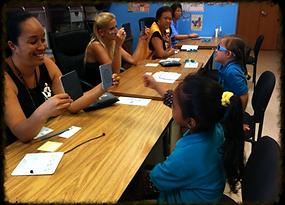
Volunteer Program:
July 2013 Program Update
Strategic Plan & Progress Report

|
What is the specific goal to be reached in this area of growth? What will be done to grow in this area? This is what we want to see happen for our students. |
|
|
What criteria will measure the progress and growth in this area? What will indicate the goal has been attained? This hard data will tell us that our vision for our students has been realized.
PROGRESS REPORT
GREEN Target Met
BLUE Approaching Target
RED Well Below Target |
Academics:
Out of sample of volunteers’ students (29), 72.4% were making proficient progress in school (i.e., teacher evaluation or GPA of 2.0 or higher). 51.7% earned at least a 2.5 GPA. A sample of volunteers’ students (17) in grades 7-11 earned a composite GPA of 2.47.
94% of volunteers reported that their service benefited their students academically (87% strongly agreed), while 94% also reported that they personally learned and developed new skills as a volunteer. Health:
93% of volunteers reported that their service made their student feel happier, and 80% reported that their time made their student healthier. 100% of volunteers reported feeling better about themselves personally, and 86% reported that their service made them a healthier person. Community:
15.1% of students (143) had a family member registered as a volunteer on campus.
3.9% of students (37) had a family member that volunteered at least 20 hours on campus. 2.0% of students (19) have a family member that has volunteered at least 50 hours on campus.
7009.3 hours of service were volunteered this year. |
Progress Details
The volunteer program continued to be a highlight program of the Navigators’ Center. Staff remarked that the Volunteer Program is one of our school’s biggest strengths in terms of connecting with the community and that its organized structure allows family members to engage in their students’ learning easily and meaningfully. Numerous family members could be found on a daily basis giving their time in classrooms, the cafeteria, the library, and offices around campus. Faculty and staff expressed gratitude for the online request system. The system allows them to get support with their often-overwhelming responsibilities, and also “makes volunteers feel like they are actually a part of something rather than just looking for something to do.” Faculty who worked with volunteers also commented that the structured volunteer program gives volunteers a sense of accountability and responsibility that provides an added benefit to many of them who are actually looking for employment.
The Center progressed the program by offering opportunities for volunteers to expand their skill sets, as evidenced by the ‘Ohana Learning Series (OLS) event aimed at volunteers. The first OLS event of the year was held in September and was aimed at supporting those family and community members enrolled in our Volunteer Program. The “Helpful Hearts: Volunteer Workshop” was an incredibly positive experience for all those who attended, leaving them with insights and resources to support both the academic successful and overall wellness of their students. Faculty and staff notice the direct impact such training has had on volunteers, reporting that attendees to the training are now taking the initiative to go far beyond “just doing busy work.” Due to this success, a second installment of Helpful Hearts was held in February 2013, during which volunteers were trained in further basic instructional strategies.
In addition to continuing the success of community volunteers in the classroom and around campus, this year the Navigators’ Center brought back the morning E Ola program. Scores of students had family members register to read and work on schoolwork together while their students eat their breakfast every morning. Now the village school philosophy can be seen in action every morning in the cafeteria.

The 7009.3 hours of service volunteered by family and community members were integral to the success of many programs and events, such as the school-wide vision screening in October pictured here.